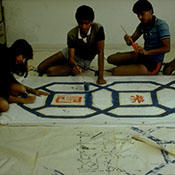 Islamic religious arts refrain from depicting symbols, images, and physical representations of God, prophets, and created beings. Islamic calligraphy, which goes back to the artistry of ‘Ali b. Ali Talib, grows with elaborate Arabic scripts and ornamentation. This religious art enhances the importance of Qur’anic verses, the Prophet’s statements, poetry, and other sacred sayings, and is used to adorn mosques, tombs, plates, and other objects.
Islamic religious arts refrain from depicting symbols, images, and physical representations of God, prophets, and created beings. Islamic calligraphy, which goes back to the artistry of ‘Ali b. Ali Talib, grows with elaborate Arabic scripts and ornamentation. This religious art enhances the importance of Qur’anic verses, the Prophet’s statements, poetry, and other sacred sayings, and is used to adorn mosques, tombs, plates, and other objects.
View Full Album
Islam is often called a “religion of the Book” because of the centrality of the written Qur’an. In Islamic art as well as architecture, the written word has assumed extraordinary value. Although according to tradition Muhammad was himself illiterate, the first revelation ordered him to recite; the full Qur’anic revelation he received was later written down in Arabic, the language of the revelation, in order to preserve the divine word.
Muslim calligraphers trace their artistry back to ’Ali b. Abi Talib, cousin and son-in-law of the Prophet. Although copying the Qur’an in beautiful script was a meritorious spiritual act in itself, early copies of the Qur’an were mere supports for the memory of reciters. For these early Qur’ans, the Kufic script with block letters was the liturgical script of choice. Calligraphers developed it, embellishing the script with flower and leaf motifs or plaiting the letters together in elaborate designs. Cursive scripts became prominent in the palaces of caliphs and eventually in the poetic and mystical texts of the 14th century.
The embellishment of Arabic script and the weaving of letters took on increasingly abstract forms as calligraphy was used in architectural decoration. Stylized Qur’anic verses, the 99 Names of God, hadiths of the Prophet, poetry, or pious sayings blended with traditional vegetal and geometric patterns in stucco and ceramic work, covering the facades of important buildings, ornamenting mosques, tombs, plates, bowls, and coins.
The religious art of Islam generally avoided concrete symbols and the physical representation of animate things. Instead, Muslim artists developed elaborate Arabic script and ornamentation, emphasizing the importance of the divine word and other sacred sayings. In mosques in the United States, calligraphy appears in inscriptions and wall decorations: driving along Massachusetts Avenue in Washington, D.C., one can see a verse from Surah al-Nur emblazoned in blue above the arches of the Islamic Center; in Manhattan’s landmark mosques, kufic script adorns the mihrab. Modern Muslim artists in this country and around the world continue to experiment with the flowing shapes of the words, incorporating Qur’anic verses and sayings in abstract designs to ornament not only buildings but also posters, t-shirts, and diverse Muslim media projects. Though advancements in graphic design have allowed for an entirely new age for expression and experimentation in presenting the sacred sayings of Islam, master caligraphers, like Mohamed Zakariya in the U.S., continue the age-old tradition of hand-made Islamic calligraphy, along with teaching and passing it down to their students.